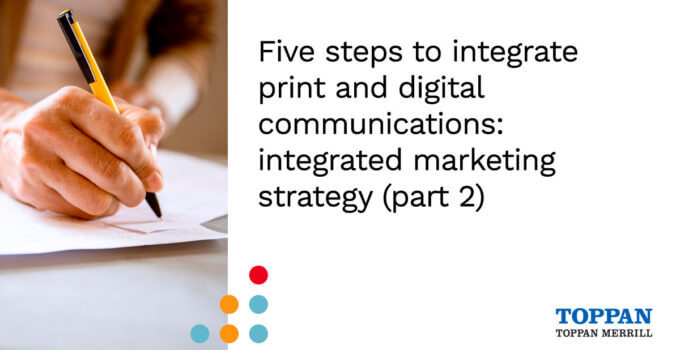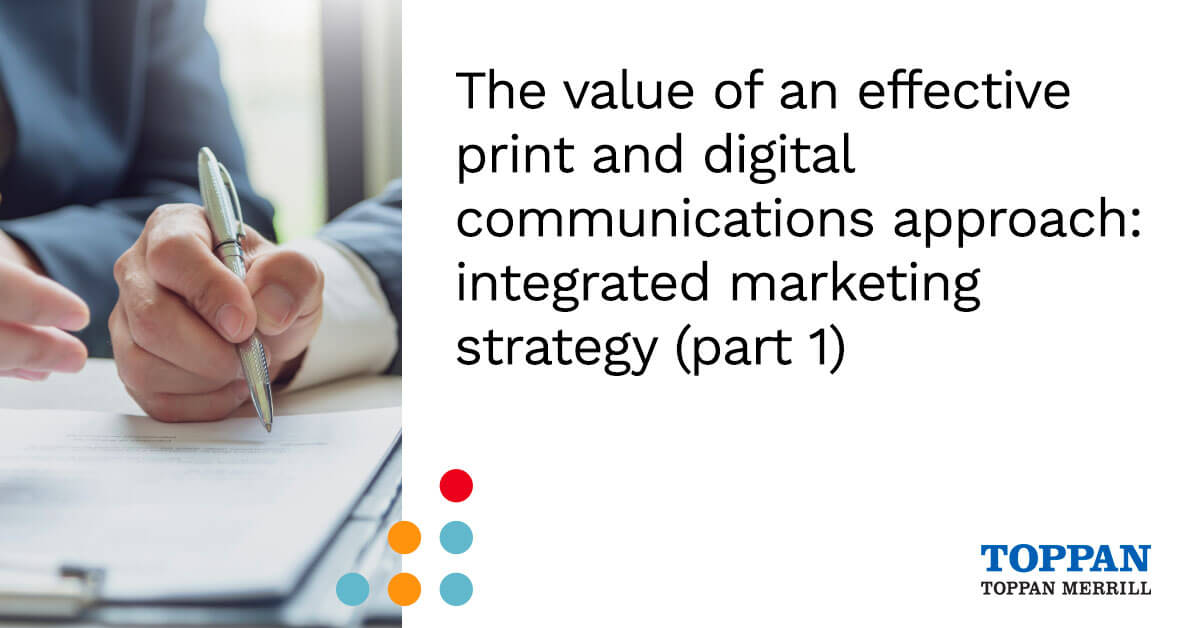As discussed in depth in the first part of this blog series, with so much digital clutter, Firms need to find new ways to cut through the digital noise. Still, many remain heavily focused on digitization, shifting all their processes and customer communication to digital-only, while customers may grow increasingly disconnected and dissatisfied.
For Firms, a digital-only approach may be cost-effective but at a cost to their relationship with customers and their revenue generation potential. This is where traditional marketing such as print can help.
Carefully designed, executed and coordinated print and digital campaigns allow print marketing and digital initiatives to seamlessly work together to deliver a powerful yet cost-effective impact.
As the sharp demarcation lines between digital and traditional marketing are becoming blurred, Firms need to align their strategy and resources to better fit the new reality. The following five-step holistic framework will ensure they put in place an effective integrated strategy that will boost marketing campaign ROI, increase customer engagement, and support profitable growth.
1. Creating a consolidated team
The shift in department structure, skills, and budget to bring the print and digital groups together
To fully leverage the power of an integrated strategy, the marketing department needs to transform from disparate functions to a single interconnected entity. Functional silos and rigid organizational structure are potent barriers that can prevent Firms from implementing an effective integrated marketing approach. As noted in our recent whitepaper, “Finding the Right Balance: Leveraging a Multichannel Outreach Approach,” this leads to vast process inefficiencies: workflow management bottlenecks, breakdowns in cross-group collaborations, and poor resource utilization, to name just a few.
Overall alignment is needed to ensure that all marketing collateral, mediums, and channels support each other and one consistent message. A clear workflow ensures that different teams are aligned, juggling multiple moving parts towards the common goal. All involved teams deliver their unique sets of skills, working towards clear goals and expectations and feeding back to each other. For example, traditional marketing teams bring their focus on brand awareness and top-of-funnel efforts, building a long-term relationship and taking more customer lifetime potential into account versus short-term emphasis. Digital marketers bring focus on more immediate impact across different funnel stages and tactics that can achieve goals at each of them. Firms need both approaches, so collaboration across marketing teams is critical.
Finally, budget alignment with the integrated strategy is critical. Firms need to select marketing venues that fit their budget and allocate resources to the selected channels to guide customers’ journeys and move prospects through the sales funnel and convert them.
2. Understanding the right balance and budget for print and digital
Fine-tuning the print and digital mix to align with customer buying habits
The most effective way to reach customers is by using a combination of print and digital, but the exact mix will depend on multiple factors. The optimal balance between print and digital will depend on a marketing campaign’s goals, which are tied to the target market and the campaign budget.
To be able to strike the right balance between digital and print initiatives, it’s important to have complete clarity on who the target audience is. With this in mind, the first step is to research and segment the target audience to ensure that efforts will actually help a Firm connect — online or offline — and avoid spending resources on marketing programs that are less likely to reach the target customers.
Once Firms identify the targeted audience, they need to define marketing goals or what they expect to achieve with a specific campaign. The goals will help select specific avenues to reach their target audience instead of using every channel available. When choosing the right digital and print mix, the marketing imperative is to meet where the customers already are.
Finally, allocating budget to each of the chosen marketing channels ensures that the selected marketing plan is implemented.
In our recent whitepaper, we propose four elements that deserve special attention:
- Focus on timing — as consumers move beyond the awareness stage in their buyer’s journey, they begin to consider multiple Firms and their offerings. At this point, they can be targeted by traditional offline communication, such as a well-targeted direct mail piece.
- Track touchpoints — to get an understanding of which touchpoints are moving the average consumer along to purchase, Firms can use automated content management systems to ensure the right content is being placed in front of the consumer at the right time, both digitally and traditionally.
- Manage production — to enable a timely launch of new campaigns and/or ongoing touchpoints in existing communication campaigns.
- Attribute successes — to find the right mix between traditional and digital channels, Firms need an attribution model that accurately assigns sales generated by different channels so that marketing spend can be aligned.
3. Ensuring consistent messaging, compliance, and reducing duplication efforts
Employing systems that accommodate both print and digital capable of shifting and evolving with your digital transition strategy
To get the best ROI from marketing campaigns, consistency in multiple impressions across various channels is key.
Print marketing should be viewed as the physical branch of a digital campaign. They are both needed to engage customers at multiple touchpoints. But they will be effective only if the messaging across different touchpoints is consistent, creating a cohesive brand identity.
To avoid disconnected marketing and the resulting lack of alignment across different channels, messaging, and strategies, Firms need processes designed specifically to ensure that all messaging and communications are consistent across all channels and centered around the customer.
Integrated marketing needs integrated systems. Effective marketing information systems are designed specifically with this in mind. Data integration allows Firms to collect and share relevant data across different teams, functions, and departments, making sure all efforts complement each other without any duplication.
With a holistic marketing system, Firms can track key metrics per each individual channel, including indicators such as the number of leads, engagement, conversion rate, cost per lead, and many more. Empowered with this invaluable data, they can continuously keep their finger on the pulse to identify opportunities and avoid steps that are less likely to lead towards the desired goal.
4. Reviewing customer data to understand the desire for digital and engagement
Data-driven marketing decisions to meet customer expectations
The advantage of digital marketing is that it is based on customer data that can be used to drive decisions.
But reviewing this data can also help Firms optimize their offline endeavors. Data collected from digital marketing efforts can also be leveraged to provide print campaigns with insights unheard of before. Just because the data originated in the digital sphere does not mean that its impact needs to be confined to the digital world. Digital data can be used to fuel the overall marketing efforts — both digital and print campaigns.
5. Being strategic about what is offered and to whom
Robust reporting to identify trends in consumption and empower sales teams with opportunities insights
An integrated marketing approach ensures that all marketing programs, online and offline, support each other by adding value at each touchpoint to enhance customer engagement and marketing ROI. Firms need to be strategic about what is offered to whom, and there are tools and frameworks that can help.
An effective customer relationship management system provides Firms with a clear overview of their customer base in one place. Through a single dashboard, multiple involved teams, including marketing and sales, can get a holistic view of all customer’s previous interactions with the Firm.
Information like previous purchases, feedback about products and services, customer service issues, but also other valuable external data, such as information from their social media activity, can be found here. All this data help create an overall picture of customer behavior, expectations, and preferences. The marketing department can use this data to optimize campaigns — both print and digital — to better understand the sales pipeline, from existing customers to prospects.
Gaining insights into the reasons that lie behind your customers’ decision to purchase from you or not is an invaluable opportunity to enhance your sales team’s effectiveness and your Firm’s ROI. Win/loss analysis provides insights into the reasons why your sales team wins some opportunities and loses others, allowing Firms to identify customers’ decision drivers and better understand what they do well and what they need to improve. These insights are used to gain actionable insights to guide future efforts so that your Firm can meet your customers where they are and be strategic about what is offered to whom across both print and digital channels. Empowered with this information, your sales team can increase win rates, and the marketing team can improve positioning.
Integrating print and digital delivers superior results
Although widespread in the marketing community, the idea that print is dead or near-dead is not founded in reality and is not supported by data and research. Studies consistently show that print marketing can significantly boost the ROI of digital marketing campaigns. Because the two approaches work so well together, relying on one or the other means that Firms are missing opportunities to cross-link their physical and digital presence.
New technologies can allow Firms to integrate print and digital marketing in creative ways and develop powerful campaigns that will create a new level of customer engagement. But, with such a pronounced specialization in the marketing universe, skills and experience that span across both traditional and digital marketing spectrums are scarce.
How Toppan Merrill can help
With more than 50 years of both print and digital marketing experience, Toppan Merrill can deliver powerful, integrated, multi-channel communication and delivery solutions in digital and print formats to expand what’s possible for clients around the world. Learn more about how our innovative single-source platform, Connect, can help you leverage omni-channel solutions to boost your customer acquisition, customer communication, and sales enablement.

